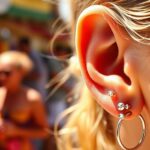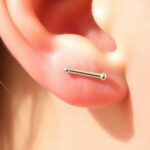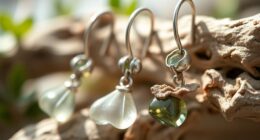When you approach airport security with body piercings, expect a few checkpoints. Most piercings won't trigger alarms, especially if they're small. However, larger pieces might prompt additional screening. TSA allows visual checks instead of jewelry removal, but be prepared for hand-held detectors to react to sensitive metal. Staying calm and cooperating with staff can make the process smoother. To avoid complications, consider wearing non-metallic or smaller jewelry when traveling. Familiarizing yourself with the latest TSA policies will help you navigate security efficiently and reduce stress. If you want tips on making your travel experience even easier, there's more to explore.
Key Takeaways
- Most body piercings do not trigger metal detectors, but larger jewelry may increase detection chances during security screening.
- TSA allows visual inspections of body jewelry; removal is generally not required unless alarms sound.
- Hand-held detectors are more sensitive, potentially alarming for larger or magnetic jewelry pieces.
- Arriving early and opting for non-metallic jewelry can help avoid delays and complications at security.
- Private room examinations with same-gender officers are available for additional screening if necessary.
TSA Overview and Guidelines

When you're heading to the airport, understanding the TSA's guidelines on body piercings can make your travel experience smoother.
The TSA operates secure screening areas where body jewelry might occasionally trigger alarms, leading to potential pat-downs or additional screening. However, most body piercings are typically too small to set off metal detectors, while larger jewelry increases the chances of detection.
Thanks to a 2008 policy change, TSA regulations allow for visual inspections of body jewelry instead of requiring you to remove them.
While instances of pat-downs due to body jewelry are rare, it's important to stay compliant with TSA guidelines during security checks. Being informed can save you time and stress.
If you're worried about your body jewelry, familiarize yourself with TSA guidelines before your trip. Knowing what to expect can ease any anxiety related to airport security.
Experiences With Body Jewelry

When you travel with body jewelry, your experiences at security can vary greatly.
Some travelers breeze through checkpoints without any issues, while others face extra scrutiny due to their piercings.
It's interesting to hear how different types of jewelry can influence these encounters and what strategies you've found helpful.
Personal Experiences Shared
Travelers with body jewelry often find themselves maneuvering through the complexities of airport security, sharing a mix of experiences that highlight both challenges and ease. Many report having no issues with their metal piercings, noting that most don't trigger metal detectors. However, some individuals have faced requests to remove jewelry or undergo additional screening, though these cases are relatively rare.
Here's a table summarizing different experiences:
| Experience Type | Description |
|---|---|
| No Issues | Many travelers pass through without problems. |
| Minor Delays | Some face requests to remove jewelry. |
| Additional Screening | Rare, but possible for certain piercings. |
| Community Advice | Cooperation with security can ease the process. |
| Notable Incidents | Instances of extreme measures, like using pliers for removal. |
Elayne Angel, a renowned figure in the piercing community, emphasizes that her extensive travel hasn't led to significant security problems. Sharing your experiences and staying calm can help smooth the process for everyone involved.
Security Screening Variability
Maneuvering airport security with body jewelry can be a mixed bag, as experiences vary greatly among travelers. While some breeze through security screening without a hitch, others may find themselves facing extensive checks or requests to remove their jewelry. Here are three key points to reflect on:
- Metal Detectors: Heavily pierced individuals often pass through walk-through detectors without triggering alarms, but larger or more metallic pieces might raise flags.
- TSA Policies: Since 2008, the Transportation Security Administration (TSA) has allowed visual inspections of body jewelry, reducing the need for removal. However, the discretion of security personnel can lead to differing experiences.
- Hand-Held Detectors: Anecdotal evidence suggests that hand-held metal detectors are more sensitive than walk-through detectors, causing more frequent alarms for those with metal jewelry.
Staying calm and cooperative during security checks is essential. Personal accounts indicate that how you react can influence the scrutiny you face.
Remember that while TSA regulations aim to streamline the process, individual airport policies and personnel can lead to varying experiences. Being prepared can help make your travel smoother.
Metal Detectors Explained

Metal detectors play an essential role in airport security, as they emit an electromagnetic field that identifies metal objects by detecting disruptions within that field.
When you walk through a metal detector, it's designed to trigger an audible signal if there's any interference caused by metal. The sensitivity of these detectors can be adjusted, allowing security personnel to fine-tune their settings based on the specific security needs of the airport.
Most body piercings made from non-ferromagnetic metals, like titanium or surgical stainless steel, typically won't activate the walk-through detectors. This means you can usually pass through without causing any alarms.
However, if you're wearing larger body jewelry, like big hoops or gauges, you may increase the chances of detection. Hand-held metal detectors, often used by security personnel for more precise checks, tend to be more sensitive than the walk-through versions. They might trigger alarms if your body jewelry is larger or made from ferromagnetic metals, like iron.
Understanding how metal detectors work can help you prepare for the security screening process, ensuring a smoother experience at the airport.
Safety and Health Considerations
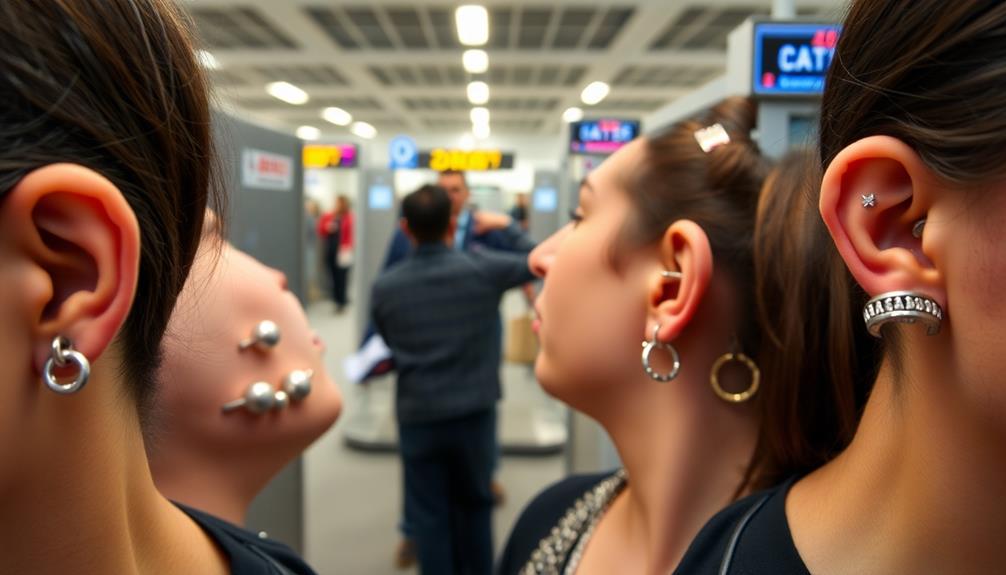
Steering through airport security can be a challenge, especially if you have body piercings. Keeping safety and health in mind is vital for a smooth travel experience.
Here are three key considerations to guarantee your body jewelry doesn't become a hassle:
- Aftercare: Proper care for new piercings is essential. Healing tissue is vulnerable to bacteria, so make sure you follow aftercare instructions to avoid infections while traveling.
- Choose the Right Jewelry: Be aware that certain metals can trigger allergic reactions. Opt for high-quality materials like titanium or surgical steel to minimize health risks. This selection can help guarantee your body jewelry remains safe and comfortable during your journey.
- Keep Healed Piercings In: If your piercings are healed, it's generally advisable to keep them in place. Removing them can lead to closure or pain, which is the last thing you want while steering through an airport.
Tips for Smooth Travel

To guarantee smooth travel, you should prepare by choosing non-metallic jewelry that won't set off alarms.
Familiarizing yourself with security procedures can save you time and hassle at the airport.
Plus, staying calm and cooperative during the screening process can make everything go more smoothly.
Prepare Non-Metallic Jewelry
Traveling with body piercings can present challenges at airport security, but opting for non-metallic jewelry can make your journey smoother. By choosing materials like Lucite or silicone, you minimize the risk of triggering metal detectors, which can lead to unnecessary delays.
Here are some tips to help you prepare:
- Choose Smaller Pieces: Wearing smaller and simpler non-metallic jewelry reduces the chance of setting off alarms, especially if you're concerned about metal piercings.
- Pre-Pack for Easy Access: Keep your non-metallic jewelry in an easily accessible part of your carry-on. This makes it quicker to take out during the screening process, facilitating a smooth passage through security.
- Know the Rules: Familiarize yourself with TSA policies regarding body jewelry. Being informed helps guarantee compliance and prevents complications during screening.
Staying calm and prepared with non-metallic alternatives enhances your travel experience, allowing for fewer delays at security checkpoints.
With these tips, you can navigate airport security more confidently and enjoy your trip without the stress of unexpected surprises.
Know Security Procedures
Maneuvering through airport security can feel intimidating, but knowing the procedures can help you breeze through the process. Familiarize yourself with TSA policies; since the 2008 change, visual inspections of body jewelry are allowed, so you won't necessarily have to remove your piercings. To minimize hassle, consider wearing non-metallic jewelry, which reduces the chance of setting off metal detectors.
It's wise to arrive at the airport early. This way, you can account for any additional screening time that may be required if your piercings trigger alarms. Also, keep in mind that security practices can vary, especially when traveling internationally—be aware of local regulations.
Here's a quick reference table to help you prepare:
| Step | Action | Notes |
|---|---|---|
| 1. Know TSA Policies | Familiarize with jewelry rules | Visual inspections allowed |
| 2. Choose Jewelry | Opt for non-metallic options | Reduces metal detector alerts |
| 3. Arrive Early | Get to the airport with extra time | Accommodate potential delays |
| 4. Stay Informed | Research local security practices | Varies by location |
| 5. Prepare Mentally | Stay calm and cooperative | Positive demeanor aids smooth travel |
With these tips, maneuvering through security should be much easier!
Stay Calm and Cooperative
Staying calm and cooperative during airport security checks can make a significant difference in your experience. When you approach the TSA line with a positive mindset, you can reduce your anxiety and facilitate a smoother process, especially if you have body piercings that might raise questions.
Practicing effective relaxation techniques, such as deep breathing exercises, can help maintain your calmness in potentially stressful situations, ensuring you feel more at ease. Additionally, understanding the importance of comfort solutions for sofa beds can apply here; just as a comfortable environment supports relaxation, so too does a positive mindset during travel.
Here are three tips to help you navigate security checks more effectively:
- Know the Rules: Familiarize yourself with TSA policies regarding body jewelry. Understanding what's allowed can empower you and prevent unnecessary complications.
- Arrive Early: Give yourself plenty of time to get through security. If additional screening is needed due to your piercings, an early arrival allows for a more relaxed experience.
- Be Polite and Cooperative: When interacting with security personnel, maintain a calm demeanor. Being courteous and following their instructions can lead to quicker resolutions if they need to conduct further inspections.
Security Procedures for Body Piercings

Maneuvering through airport security with body piercings can be straightforward if you know what to expect. Since 2008, TSA policy allows for visual inspections of body jewelry, meaning you mightn't need to remove your piercings during screenings.
However, keep in mind that hand-held metal detectors are often more sensitive than walk-through ones, which can trigger alarms for your jewelry even if the larger detectors don't.
If you have irremovable piercings, you may be treated similarly to travelers with metal implants, leading to additional screening if alarms sound. In these cases, security personnel might request an inspection of your piercings.
For your comfort and privacy, they often offer private room examinations by same-gender officers.
To enhance your travel experience, it's essential to cooperate with the security staff and stay aware of local airport policies regarding body jewelry.
This proactive approach can make the process smoother and more efficient, allowing you to focus on your journey rather than potential complications at security checkpoints. Knowing these security procedures will help you navigate the airport with confidence.
Jewelry Alternatives and Recommendations
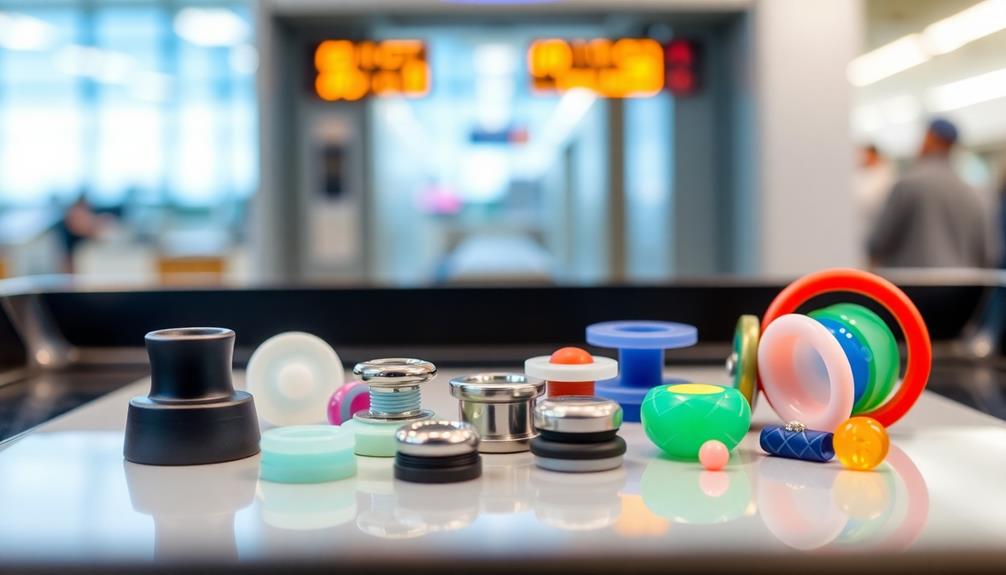
When it comes to maneuvering airport security with body piercings, choosing the right jewelry can make all the difference. To facilitate a smoother experience while traveling, consider these jewelry alternatives: Additionally, using materials that are less likely to irritate your skin can enhance your comfort during travel, especially if you're wearing your piercings for extended periods piercing care and hygiene.
- Non-metallic options: Go for jewelry made from materials like Lucite or silicone. These options won't set off metal detectors and will help you breeze through security.
- Clear retainers or plugs: These are perfect for maintaining the integrity of your piercings without drawing attention. They minimize detection issues during visual inspections.
- High-quality titanium jewelry: If you prefer metal, opt for non-ferromagnetic titanium. It typically won't activate walk-through detectors, but be prepared for potential visual inspections.
Avoid wearing long spike-style jewelry, as it may be deemed a weapon and could be confiscated.
Being informed about airport-specific policies and choosing minimal metal jewelry can greatly improve your travel experience. By opting for these jewelry alternatives, you'll reduce the likelihood of complications at security checkpoints, allowing you to focus on enjoying your journey.
Community Insights and Resources

Many travelers find that sharing experiences about body piercings and airport security can be incredibly helpful. Community discussions often highlight personal stories that shed light on what to expect during security screenings.
These shared experiences can help you navigate the complexities of traveling with body jewelry, especially when it comes to dealing with TSA regulations. Resources like "The Piercing Bible" by Elayne Angel provide essential guidance on body piercings and their implications for travel.
This knowledge can empower you to make informed decisions before heading to the airport. Additionally, online forums and social media groups are treasure troves of real-time updates and tips from seasoned travelers who've successfully managed security screenings with body jewelry.
Awareness of TSA's revised policies, such as the option for visual inspections instead of mandatory jewelry removal, can greatly benefit you as a pierced traveler. Engaging with communities focused on body art and travel fosters a supportive environment where you can exchange advice and strategies.
Frequently Asked Questions
Do Body Piercings Set off Airport Security?
Body piercings can set off airport security, especially larger ones. If you've got smaller jewelry, you're less likely to trigger alarms. Just be prepared for possible visual inspections if security needs to check your piercings.
Do Earrings Need to Be Removed for Airport Security?
They say, "Good things come in small packages." Most earrings won't need removal at security. If yours are larger or might trigger alarms, just be ready for a quick visual check or removal.
Do You Have to Take Nose Piercings Out at the Airport?
You typically don't have to remove your nose piercing at airport security. Most metal detectors won't trigger, but if they do, be prepared for a visual inspection. Stay calm and cooperate with security personnel.
Can I Go Through TSA With a Septum Piercing?
You can generally go through TSA with a septum piercing without needing to remove it. Just stay calm and cooperative if security checks it. Consider non-metallic jewelry to avoid potential alerts during screening.
Conclusion
In the grand adventure of air travel, maneuvering through airport security with body piercings doesn't have to be a hassle. By embracing the guidelines and preparing for the metal detector dance, you can glide through security with ease. Remember to pack your jewelry alternatives and keep your spirits high. With a little foresight and a sprinkle of patience, you'll be on your way to new destinations, all while keeping your unique style intact. Safe travels!
Hi, my name is Danielle, and I’m an author for piercings-body.com. I have a passion for writing and love to share my knowledge on all things body piercing-related. I’m also a huge advocate for safe body modification practices and believe everyone should be able to make informed decisions about their bodies. When I’m not writing or blogging, I enjoy spending time with my family and friends, practicing yoga, and exploring new places.




